In any fantastical story or mythical tale, one may find immersive beauty in the incorporation of mysticism that is lacking in day-to-day reality. Whether you’re a player exploring new depths of character development or a Dungeon Master on a quest for inspiration, integrating tarot card reading into your adventure is a reliable way to spice up your game.
Below are several suggestions on how to use tarot cards as a player or DM in your adventure. Don’t forget to check out the table at the end of this article for an easy tarot card reference translated to D&D terms with example readings!
Tarot Resources:
I enjoy using this website for information and insight into tarot card readings. The first and last two paragraphs will provide quick interpretations, but each entry is thoughtful and helpful.
Use Tarot Cards to Determine Character Arcs
While players get to decide what their characters want to achieve, a Dungeon Master can determine through a tarot spread what shape those desires take in their campaign and how a player ultimately achieves these goals. For simplicity, a Dungeon Master may choose to use only the 23 Major Arcana cards in a deck, but for a greater range of inspiration, they may choose to use the entire deck.
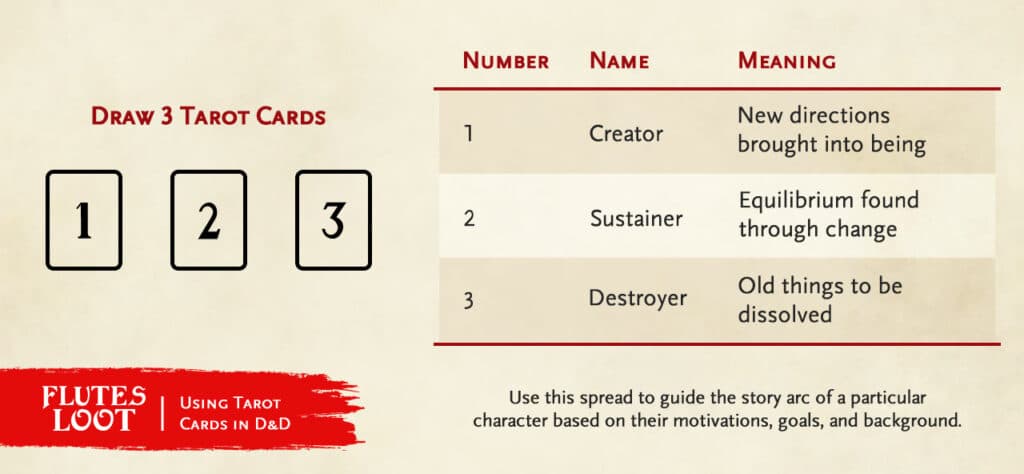
Draw 3 cards. Reveal them in the following order: Creator, Sustainer, Destroyer. These will be external forces that drive the character’s choices throughout the campaign.
- Creator: The Creator supplies new situations and purposes into the character’s life. Remember that both positive experiences and challenging problems can create new opportunities.
- Sustainer: The Sustainer allows the character to find balance among change. The Sustainer gives the Creator structure while holding the Destroyer in balance, recognizing that both are necessary but neither is sufficient to reach one’s goals.
- Destroyer: The Destroyer is the force that identifies what must be consumed or removed to reach one’s goals. Although constraints are painful and frustrating, these conflicts give shape to the character’s development. The Destroyer removes the extraneous and obsolete, keeping the wheel of progress turning.
How these elements affect the campaign:
While the tarot cards themselves will not provide exact direction on how to write your campaign, the messages and ideas found within the cards’ descriptions can provide inspiration and guidance. The three cards can apply their effects simultaneously or in separate settings, and I recommend either establishing a spread for each player or for the campaign as a whole.
Creator: Given the sentiment of the card drawn, a number of things could push a player to action. For instance, should the Emperor card arise, the player may find themselves under new and strict rules or regulations, perhaps imposed by their deity or a governing force, that allows them to grow closer to their goals in an unexpected way. If the card drawn were Death, the player may experience an opportunity to shed a former belief, bond, flaw, or ideal in order to develop into a character who reaches their goals.
Sustainer: Cards in the Sustainer position should be seen as elements in the campaign that provide the character stability. The Sustainer is a stationary point from which the character can observe the change happening. Let’s suppose the card drawn for the Sustainer is the Empress, which embodies protective and unconditional love. The character may find solace and protection in a safe zone where they can self-reflect and recover. Through roleplay, an NPC that may represent a mother-like figure may provide guidance and an environment where the player can make mental connections about the campaign around them. If the Sustainer card drawn is the Tower, typically a formidable card, perhaps that balance is found when old “structures” or conceptions are demolished and peace is discovered, as ignorance is removed and wisdom is found.
Destroyer: As a force that removes the elements of a campaign that limits a character’s options, the Destroyer is an obvious catalyst for change. As an example, if the Hanged Man is drawn, perhaps a character needs to let go of their desire for knowledge, which can lead down wicked paths. Should the Lovers card arise in the Destroyer position, a player may need to forget the thing they desire altogether and find a new purpose, as their initial goals turn out to be detrimental to themselves or those around them.
Use Tarot Cards to Discover Flaws and Bonds
Players developing their character before gameplay may use tarot cards to create a deeper character response in the forms of flaws, bonds, ideals, and goals. While a player should already have an idea of what kind of character they wish to play, this method will provide basic guidelines that a player can integrate into their already-conceived background.
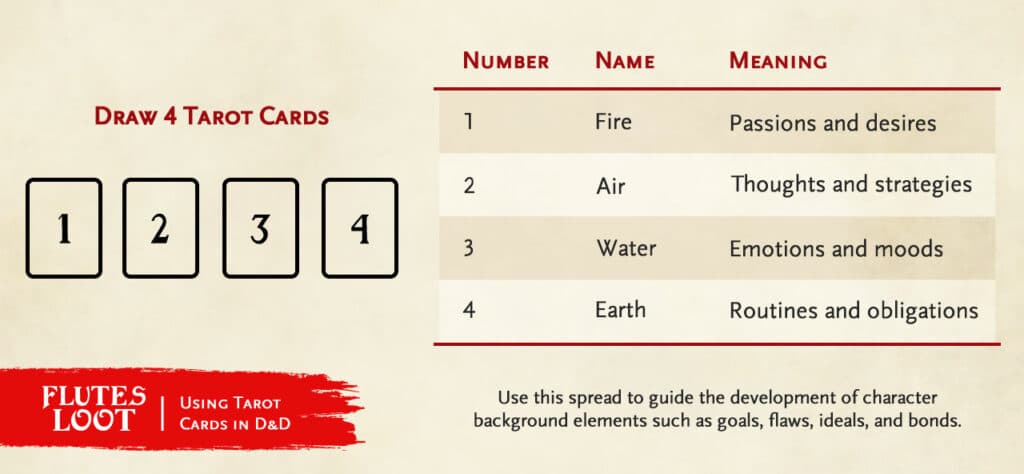
Draw 4 cards. These cards will correspond to the four “elements” and determine how your character acts emotionally, spiritually, physically, and mentally. Any or all of these cards may help determine flaws, bonds, ideals, and goals in a positive or negative light.
- Fire: Passions and desires. Fire is the untainted driving force of a character’s identity. This card will determine a player’s goals as if there were no physical or emotional limitations.
- Air: Thoughts, strategies, and concepts. Air is the instinct to control one’s passions, constrained by rational thinking and objectivity that provide a sustainable solution to achieve one’s goals.
- Water: Feelings, emotions, and moods. Water is subconscious anxiety that draws us inward to safety rather than adventuring. It can symbolize emotional or physical attachments and subconscious intuition.
- Earth: Practical matters, daily routine, obligations. Earth is the security of shelter and practical resources that protect and preserve us physically.
Example draw:
- Fire. Ace of Swords: Swords cut both ways. The revenge you desire will both satisfy and hurt you.
- Air. Hermit: Though prone to brashness, inner reflection has helped you to be cautious about seeking revenge. To plot a fair and just revenge, perhaps you live as a hermit so as not to give in to your passions foolishly.
- Water. Two of Pentacles: Knowing that life is on the verge of chaos causes you to withdraw emotionally from making connections with NPC’s who are helpless.
- Earth. Seven of Wands. Fear drives you to withhold your ultimate power for your own safety, and the safety of those who trust you, but that same fear of losing those you do care for emboldens you to fight courageously.
From this draw, we can determine the following details:
- Background: Hermit
- Flaws: Prone to brashness in the heat of the moment. I throw up emotional walls so that I won’t get hurt by others’ misfortune.
- Bonds: I am bound to the memory of the person I lost by the hand of those I seek revenge against, though their death was a result of my own brashness.
- Ideals: I must defend the weak so as not to have the loss of life on my conscience.
- Goals: I will bring justice to those who have hurt me, but do it cautiously so that I do not hurt anyone who does not deserve it.
Use Tarot Cards to Seed Campaign Elements Early On
One of the first encounters in Curse of Strahd (no spoilers!) is a tarot card reading that determines the direction of the entire campaign by incorporating tips, hints, and secrets that players can reference and follow. By doing so, they’ll gain magic items, receive destined allies, and learn tactics for completing the module. Another tool Dungeon Masters use in this module is leveling up players when they fulfill one of the cards.
Along those lines, a Dungeon Master can ask players to draw a card each in Session 0 without explanation to its description. Over time, a player will begin to understand the concept of the card, as the Dungeon Master decides how the card relates to the character. This card can flavor their entire character arc as NPC’s, encounters, and divine intervention can reference the card whenever a player needs to pay attention, or when something is specific to the character’s arc.
For example, if a player draws the Moon, such motifs can manifest at appropriate times that focus on the player: events for their development occur at night with the moon cycle; lycans are particularly interested in (perhaps friendly to) this character; a knight order with the symbol of the moon on their breastplates can become allies; moon-related deities might manifest to the player.
Less-overt occurrences may revolve around the sentiment of the card. Moonlight is misleading, as the moon simply reflects the light of the sun, and the face of the moon is an infamous illusion. The character may be more susceptible to illusions throughout the campaign, being deceived by a two-faced NPC, illusion magic, a false prophet or leader, and so forth. For a big payoff, manifest the symbol of the moon when these illusions are revealed.
Another example of a card drawn could be the Hermit. A player may find themselves separated from their party and required to look within themselves to grow before reuniting with and bringing light to the party, perhaps in the form of knowledge, powers, or magic items. A mentor could enter the character’s life, though one who does not overtly teach, but guides them to self-expression through experience. A player may find themselves bereft of all of their equipment except a lamp for light, which is running out of oil. Perhaps this character has a shining backstory that will be revealed, intertwined with deities and a powerful pantheon, that can only be understood when they reach enlightenment.
Use Tarot Cards to Give Players Helpful Clues
Players may feel challenged in overcoming something puzzling or difficult. A Dungeon Master can cleverly sow hints of how to triumph over these challenges with a tarot reading.
Suppose players need help finding the lair of the villain. A Seer can tempt them with a card drawing. Through this reading, players gain two to three hints about where they will find success, and a few warnings about what traps to look out for.
This method of tarot reading is very loose and easy for a Dungeon Master to improvise on the fly. Draw any number of cards and look at the symbols and iconography on the card. Draw players’ attention to the specific elements that would help in their challenge. Use mysticism and vague generalizations at first, then sprinkle in specifics as they relate to the challenge at hand. A Dungeon Master might also ask players to roll Perception, Insight, History, Arcana, or Nature checks to give these very specific clues after hearing the general interpretations.
Use Tarot Cards to Establish NPC Characteristics
As described in Van Richten’s Guide to Ravenloft (pg. 40), a Dungeon Master could use a tarot deck (such as the Tarokka deck from Curse of Strahd) to shape the fates by determining which Darkness Domain the Darklord hails from. Use the tables in the “Creating Domains of Dread” section and pay attention to the suite, orientation, and details in the tarot cards you draw to inspire your decisions on which elements to include.
However, this idea goes beyond Van Richten’s Guide to Ravenloft. For instance, a Dungeon Master could draw cards and reference a random table of character details, such as this one from Pathfinder and use the card’s number (determine beforehand which minor arcana suite corresponds to each number in the ten’s place), and use the card’s iconography and interpretation to decide in-depth NPC details.
Use Tarot Cards to Send Players on Quests
Just as a Dungeon Master can easily improvise card readings to give players hints, a Dungeon Master can inspire players who are sandboxing or at a loss of what to do next with a myriad of plot hooks via tarot card readings.
Because tarot cards are rich with visual symbolism, a Dungeon Master could have several cards ready that set players on quests or draw them on the fly and improvise how they relate to plot hooks.
Players come across a leathery soothsayer who seems to know details about their past and inner workings, with promise of certain fates to come. The soothsayer will draw a few cards and explain how the players relate to the cards: they are on a Fool’s Journey that will bring greater enlightenment. They will encounter a Dark Tower in the north with surprising evils at play. They must beware She who Holds Seven Cups, who bestows strange and wonderful gifts, who is found near a large body of water.
Use the table below for inspiration on how to flavor these cards, and use the symbols and iconography of the cards to determine what plot hooks you will sow amongst your players.
Use Tarot Cards to Draw for Random Loot
Random card drawings are always exciting, as fate is in the hands of the players. Dungeon Masters may find tables of magic or mundane items and have cards correspond to loot. Players will draw a card and receive items based on that card.
Dungeon Masters could also look up the interpretation of a card draw and correlate a magic item based on that description. Where some cards are foreboding, magic item could be cursed or inspire dread.
Use Tarot Cards to Help Players Look at Challenges in a New Light
When players complain about a situation or can only seem to see a problem from one side, a 3-card pyramid tarot reading can give them introspection and reflection. This idea may not jive with all types of players, as some enjoy roleplaying and story-building less than others. Determine beforehand if this is the right idea for your party.
A Dungeon Master may wish to establish this read beforehand, but can easily do so on the spot, encouraging players to interject to make these connections themselves.
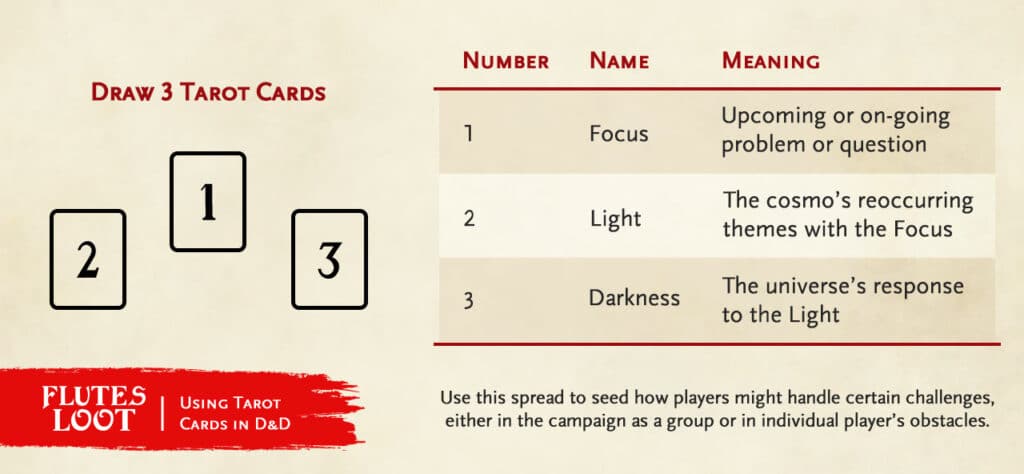
Draw 3 cards. In order, the first card (center) will be the Focus of the reading, the second card is the Light, and the third is the Darkness. A Dungeon Master may wish to use only Major Arcana, but including the Minor Arcana will add more options for depth.
- Focus: This card represents the problem or question at hand, or may reflect an upcoming challenge to face.
- Light: The second card signifies how the world around them influences the problem, such as which motifs and symbols are present in the challenge, and what ideas are asserting themselves.
- Darkness: The final card represents the implied absence of light, or the other side of the coin. This card explains how the universe is responding to the second card, or the consequences of the Light.
Example Reading
Conceptually, this spread is a bit difficult to understand, so I will illustrate it with a reading:
Suppose players just lost a magic item to a rival that would have helped them defeat a Big Bad. Without the item, they are not confident that they can win the fight and are contemplating jumping ship from their looming plans. A wise oracle prompts them to a reading, and the following cards are drawn:
- Focus: Five of Swords, which shows a scene in which two men are cheated out of a victory.
- Light: Eight of Wands. Like a lightning rod, this card refers to decisive action and a sudden release of energy, or a burst of power.
- Darkness: The Chariot, a card of emotional force and control, and the power of the mind to shape the desires of the heart into expression. This card represents discipline necessary to control one’s emotions.
Result:
- The Focus is obvious and literally the problem at hand: players lost an item and were cheated out of victory, or so they believe. A cold reading might not result in such a complementary card, but elements of any card can represent the problem at hand.
- The Light card, which asks the question “what insists on being acknowledged” can prompt players to seek another source of power comparable to their magic weapon, or to act swiftly and attack their opponent now, with or without the magic item. Perhaps this signifies that the rival was working for the BBEG to attain the magic item and buy him some time, so the villain will be caught off-guard if players attack suddenly.
- The Darkness card prompts “What is the other side of the coin? What is hidden?” As a last resort, the villain may attempt to manipulate the players emotionally in order to get the upper hand. Perhaps he holds a precious captive and will threaten them when the players show they are about to win. Players are here cautioned against making decisions based on emotions and to be stalwart to the important task at hand, despite fears and distractions.
Determine tactics that may be used in an upcoming fight.
While this reading may help players determine what to do about a challenge, it may also provide a Dungeon Master with tactics the villain may employ in an encounter. Drawing and analyzing tarot cards in this regard should provide Dungeon Masters with several inspiring ideas to implement into their campaign.
Bonus Idea: Wizard of Oz Reading for Magic Item Sales
Early in the Wizard of Oz, Dorothy as a runaway comes across Professor Marvel, a charlatan seer with a crystal ball, who equates to the Wizard at the end who gives gifts (shallow or otherwise). In a line similar to this character, introduce a traveling salesman of incredible magic goods. However, the selection of magic items is based entirely on tarot card reading. Depending on the future he predicts, the seller will determine which magic item a character will need. At the end of the reading, the players will have the chance to buy the magic item.
Draw 3 cards. In the pyramid formation described above, predict an upcoming challenge (Focus), elements of the challenge (Light), and unexpected byproducts (Darkness).
Again, prepare in advance or use the tarot table below to do a cold reading on the spot. Determine which magic items would be helpful to a player based on the reading. The brilliance of this encounter is that the salesman could simply be blowing smoke and absolutely wrong in his predictions.
Nevertheless, vagueness is preferred in this reading, as a Dungeon Master can either use the cards to guide the magic item decision or form the campaign to loosely fit the card reading. Players may not understand what the reading means, and that is perfectly okay.
Use Tarot Cards to Reward Your Players with Blessings from the Gods
With the mysticism that surrounds deities in Dungeons and Dragons, implementing tarot cards in relation to encounters with deities can draw deeply on that otherworldly motif. When a player has shown exceptional courage or accomplished a great deed, draw a tarot card for that player and use its description or iconography to determine a skill boost, extra feat, free spell, magic item, reward, or new ability.
Example: a Paladin stayed behind in a burning village to save an orphanage. The deity worshipped in the village, though lesser-known, manifests to the Paladin with thanksgiving and accolades.
The Paladin draws the Page of Pentacles card, which exemplifies the most responsible of Pages who is ready to accept great responsibility. The deity appoints the Paladin a Demi sidekick to command and utilize. The player receives the stat block of the Demi and oversees it in the campaign.
Use Tarot Cards to Roleplay Charisma Checks — Use Lightly!
In a social encounter, a character who is renowned for their clairvoyance (such as an oracle or seer witch) may turn the tides of fate by manipulating NPC’s into doing their bidding via a tarot reading.
Whether a character is good in sleight of hand and can draw desired cards at will or has brilliant Persuasion to convince a player that a symbol means what they explain it means, tarot reading may be a sure-fire way to bring exciting roleplaying into social encounters. Beware, use this method lightly, either quickly or seldomly, so as to reserve its excitement appropriately.
Keep in mind, as with all encounters involving roleplaying Charisma, that a player’s lack in ability to explain or adequately convince in real life does not directly translate to a player’s lack of ability in-game, as dice rolls should determine this. The Dungeon Master, however, will determine the DC of the social encounter, which they might lower if they believe the player is doing a fantastic job.
Discuss this tactic with your Dungeon Master beforehand and determine what kind of knowledge your character may have about the non-player characters you’re dealing with based on history, background, and general abilities in reading people.
Tarot Explanation Table
While there are many resources available that explain tarot cards, I’ve developed a table for your easy reference with additional ideas on how the cards relate to Dungeons and Dragons. This table only includes the Major Arcana but should help Dungeon Masters outline how to use the Minor Arcana.
| Card | Possible Meaning | Related to D&D | Keywords |
|---|---|---|---|
| The Fool | The Fool is the spark that starts a journey. He is naive and unaware of upcoming challenges. He is unmoulded pure potential heading toward possibly rewarding risk. | Seek new plot hook; stay on the path you’ve chosen; you’re overlooking something important; great and necessary challenges lie ahead on this path. | Zero, beginning, naive, innocence, potential, present, risk |
| The Magician | The Magician is a conduit for higher power. He uses his will to make something from nothing. He commands and shapes the world. | Change your failures into succcesses; you have access to higher powers; your Constitution is strong. | One, infinity, power, will, Constitution, magic, caster, creation, destruction, individuality, confidence, control |
| The High Priestess | The High Priestess is the veiled power source the Magician gives shape to. She is the unconscious mind and its powers. | Seek greater Wisdom; explore your inner conflict; power comes from mastering the mind and self. | Two, intuition, veil, mystic, inward power, inner mind, fate, shadow, passivity |
| The Empress | The Empress is the creator of the physical and material. She is a mother archetype who loves unconditionally, but may possibly overprotect and stifle. | You will find safety here; seek greater Strength; beware staying in comfort and safety. | Three, mother, beauty, abundance, love, overprotection, stagnation, fertility, perfection, goddess, creativity, creation, harvest |
| The Emperor | The Emperor is the Father of the mind. He provides structure and regulates. He is wise and rules with a firm hand. | Seek greater Wisdom; align yourself with a leader or ruler; find a wise mentor; hard choices require Concentration. | Four, mind, power, father, concentration, rules, law, mentor, king, protection, order |
| The Hierophant | The Hierophant is the archetype of the spiritual world. This is the card of belief and institutions. | Commune with your deity; follow tradition; stay the course; seek religious powers. | Five, religion, deities, spiritual, beliefs, secret knowledge, cult, balance, conformity, traditions, mastery |
| The Lovers | The Lovers represents relationships and the duality of choice. | Trust in the relationships you’re building; consider all consequences before acting; invest in Wisdom; resolve two conflicting choices. | Six, air, fire, union, choice, emotion, love, passion, blaze, destruction, spirit, mind, crossroads, guidance, relationships, conflict, masculine and feminine combined |
| The Chariot | The Chariot embodies emotional mastery by transcending fears and restrictions. | Trust in your own power; drive toward your goals; seek a mount or companion that will balance you. | Seven, water, emotional control, trained, triumph, bridled, balance, discipline, inner strength, wisdom, spirit, mastery |
| Strength | Strength represents fortification of character in courage and patience. | Embrace elements of the beast within; focus on Strength; be patient and the path will appear to you. | Eight, fire, courage, heroics, patience, emotionless, beast, control, power, unstoppable, intuition, mind over matter |
| The Hermit | The Hermit enters the dark night alone with just a lamp, running out of oil, in search of answers and power. | Enter the dark alone to find answers; find a guiding mentor; rid yourself of a magic item. | Nine, earth, existence, purpose, seeking answers, lamp, wisdom, seclusion, stoic, isolation, darkness, wisdom, journey |
| Wheel of Fortune | The Wheel of Fortune turns despite our actions. It is a representation of fate, destiny, and cycles. | Events are out of your control; all that lives must die; remove necrotic scourges that break the natural cycle of life. | Ten, fire, fate, destiny, cycles, circle of life, rise and fall, wisdom, luck, change, certainty, powerless, inevitability, crisis, opportunity, new directions |
| Justice | Justice is the universe’s law, invisible principles that keep the world flowing. | Remember your past deeds; beware future deeds; right your wrongs; seek greater Wisdom. | Eleven, punishment, reward, law, order, karma, cause and effect, reap what you sow, judgement, guilt |
| The Hanged Man | Representing the Norse god Odin in his quest for knowledge, the Hanged Man chose to hang from the tree, something nobody wants to do willingly, in order to gain wisdom. | Seek greater Intelligence by doing something undesirable; find runes/book for more knowledge; go with the flow; the simplest answer may not be the best; release desire for control; stop struggling; seek help; turn the problem upside down. | Twelve, Odin, World Tree, mysteries, knowledge, paradox, vulnerable, sacrifice, upside down, relax, flow |
| Death | Death represents the end of one thing, changing into another, as nothing is absolutely destroyed, only transformed. | Change your behaviors; end of something; finish this quest; bring the end of something or someone; kill a creature; accept change. | Thirteen, unknown, fear, transformation, endings, transition, reincarnation, change, inevitable, resurrection, rebirth, sacrifice, destruction |
| Temperance | After change comes the renewal of balance. Temperance represents health, inner peace, and moderation. | Seek improved Constitution; you’ll find peace as something resolves; search for balance. | Fourteen, reconstruction, harmonization, moderation, balance, well-rounded, good relationships, coming together, inner peace, health |
| The Devil | The Devil represents a loss of control because one is willfully ignoring the shadow or the negative. | Become true neutral; embrace the dark side of yourself for greater power; seek a dark patron; gain control over yourself. | Fifteen, negative, shadow, ignorance, hurtful wisdom, cancer, inverted, pentagram, bound, controlled, willful imprisonment, out of control, darkness |
| The Tower | The Tower is a decrepit building without a foundation that must be torn down and reconstructed. | Let go of ideas that don’t serve your purposes; stop focusing on material things; a building must be destroyed; you are being deceived by an illusion. | Sixteen, destruction and creation, pain in change, illusions, bad foundation, decrepit, bad structures and institutions |
| The Star | The Star lights lost travelers’ ways to enlightenment. It gives hope to the wayward without revealing solutions | Find a light to lead you back on the path; one choice outweighs the other; seek divinity; commune with your deity for answers. | Seventeen, light, faith, divine, forthcoming answers, wisdom, guidance, hope, inspiration |
| The Moon | The Moon deceptively reflects the light of the sun, but also represents cycles. | Invest in Perception; you are deceived by illusions; seek the moon goddess Selune; let your intuition guide you. | Eighteen, illusion, lycanthropy, canine, misleading, fertility, Selune, cycles, deception, manifestations of fears and desires, false perceptions, uncertain destinations, imagination |
| The Sun | As the sun rises each day, the Sun card is a symbol of stability, power, and illumination. | Seek guidance from your deity; expose the darkness; there is hope; a new cycle is rising. | Nineteen, life, light, deity, clarity, reliability, control, power, strength, wisdom, calm, success, completion, joy, happiness, stability |
| Judgement | The Judgement card brings about reckoning, cleansing, and change necessary for spiritual growth, which results in reward. | Major change is under your control; create without destroying; seek non-material planes of existence; there will be effects to your actions; the spiritual will reconcile with the material. | Twenty, transition, cleansing, transformed, effect, reward, toll, reconciliation, rebirth, major change, preparation, reckoning, new beginnings |
| The World | The World represents the end of the Fool’s journey, the end of one cycle. Desires have been achieved and power reached. | There is a clear path to achieving goals; things are about to end; you will commune with the divine. | Twenty-one, union, balance, finish, ending, completion, immortality, vindication, power, rest, accomplished, transcend |
How to Use Tarot Cards in D&D 5e
- Determine character arcs
- Enable character introspection
- Foretell campaign events
- Generate ideas and inspiration
- Roleplay social encounters
- Reward heroic accomplishments
- Establish NPC characteristics
- Send players on quests
- Randomize character loot
- Roleplay Charisma checks
Speaking of seeing the future, you might enjoy Flutes’ take on whether the Divination Wizard’s signature feature, Portent, is as good as players assume it is. Check it out!

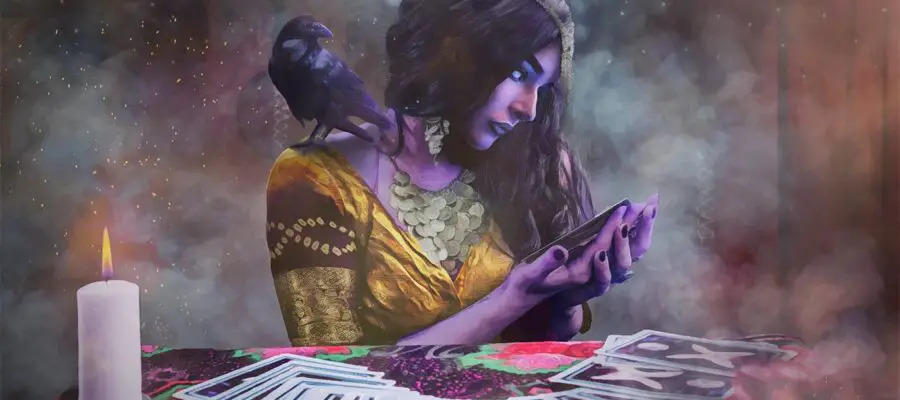


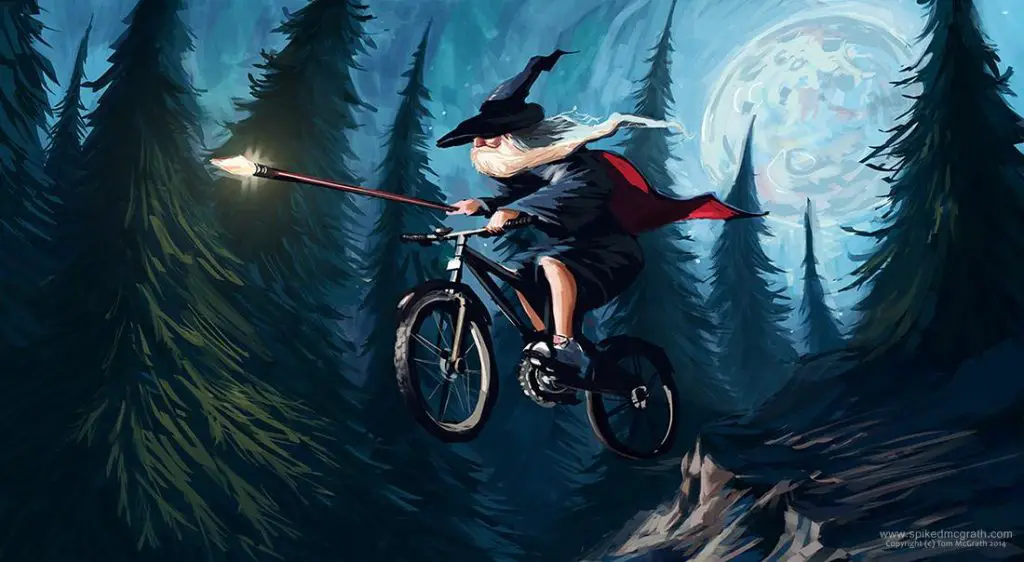
I’m so thrilled I found this! I’m going to DM a side quest for the 1st time & decided to do something like this. Each of the players will be “asleep” & an old crone will have each of them shuffle & draw 3 cards. This is very helpful for giving me more than just the personal BS & hints I need to slip them. I want to do this w/ them handling each 3 cards personally so they feel more involved (& not cheated). They’ll then “wake up” fully rested. What a help your page is!
This is a great concept! I’d love to hear how it goes and how the players react 🙂